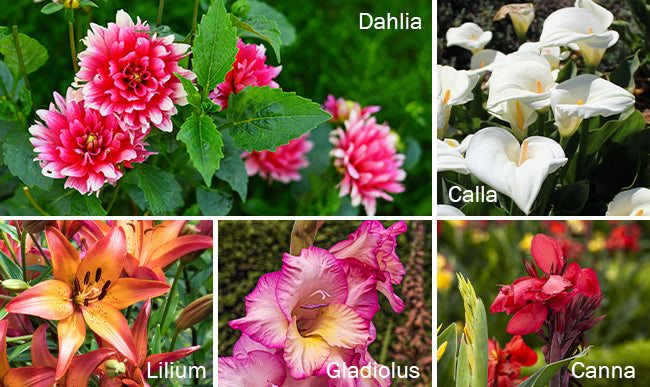For finding unusual plants, creating a distinctive, extraordinary planting composition and exploring new ways to use plants in your garden, there's nothing like bulbs.
Spring bulbs
Spring bulbs, also referred to as hardy bulbs or perennial bulbs, should be planted in autumn (September and October) before the ground freezes so they flower in spring (April to June). Tulips, hyacinths and other perennial bulbs have that special characteristic of having a bulb or corm that can thrive underground over the winter. They're sold in garden centres starting in late August.
Summer bulbs
Plant summer bulbs, also referred to as annual bulbs or tender bulbs, in spring (May-June) so they flower during the holidays (July to October). These can't survive in the ground in winter. They must therefore be dug up and kept inside until they are replanted early the following spring. They're sold in garden centers starting in April.
So many uses
Bulb plants will provide continuous flowering from the time when the snow begins to melt until the late autumn frost. Like annuals and perennials, perennial bulbs are generally grouped according to their height, their colour and their flowering period.
Where to plant:
There is a recent trend towards planting bulbs in unexpected places as if they grew there by chance.
- at the foot of trees and bushes,
- among perennials and ground covers: with time, daffodils, anemones and scilla will form a whole carpet of colour.
- in the lawn: small early-blooming bulbs such as crocus and scilla go well out on the lawn, scattered in small irregular groups. They are really lovely under trees. They are easy to plant if you use a bulb a trowel.
- in annual flower beds when they have finished blooming,
- on the edge of oriental gardens,
- in a rockery. Rock gardens are ideal for perennial bulbs.
- in flower stands and pots, where space is at a premium, you can plant various bulbs at different levels, with the late flowering bulbs on the bottom and the early flowering ones on top. For example: (starting at the bottom) Ornamental Garlic, Tulip, Crocus, Daffodil, Grape Hyacinth, Winter Aconite.

Winning combinations
For the first flowering in flower beds, companion plant bulbs with perennials that have leaves able to camouflage the yellowing foliage of your bulbs after they flower.
Plant for-get-me-nots and pansies in between your tulips. They will all bloom at the same time but they have different heights so you'll achieve a sense a vertical volume.
Companion planting of spring bulbs and perennials: Daylily and Daffodil, Hosta and Tulip, Fritillaries and Female Ferns, Bearded Iris and Wildginger, Squill and Sea Thrift.
Bulbs for the edge of your pond: Fritillaria, Daffodil, Caladiums, Callas or Elephant Ears.
Bulbs that naturalize: Glory-of-the-snow, Crocus, Winter Aconite, Snowdrop, Squill and Daffodil.
We like them because
Easy to grow: simply place its bulb on the water, and the Water Hyacinth will flower. It's that easy.
Astonishing: the Fall Crocus's autumnal blooms peeking out from the dead leaves will amaze you, and so will the crepe paper petals of the Persian Ranunculus.
Seminal: plant 10 squills and you'll soon have 1 000. They spread like butter. If you leave anemones, daffodils and scilla in the ground they will seed and produce lovely huge colonies over the years.
Original: the ruffled feathers of the Parrot Tulip, the Caladium's spray-painted leaves, Giant Garlic's impeccably globular umbels, Crown Imperial's circle of carillons and its spidery halo, the Canna and its tropical giant look.






